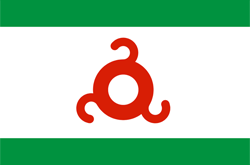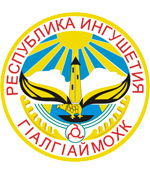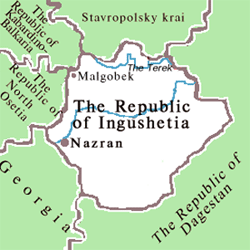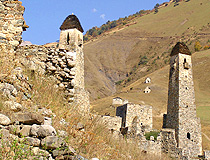History of Ingushetia
In the 10th century, an independent state of the Alans formed in the region with the capital in Magas (“the town of the Sun”). In the first half of the 13th century, it was destroyed as a result of the Mongol conquests. The territory was incorporated into the Golden Horde.
However, the Mongols could not conquer the mountainous part of present Ingushetia. The Alans preserved their language and culture in the mountains of Ingushetia and the surrounding mountain areas of Chechnya. Ingush communities living in the mountains began to return to the plains in the 16th-17th centuries.
In 1770, Ingushetia joined the Russian Empire. In 1810, in Vladikavkaz, the Ingush representatives signed the act of oath with Russia. In the same year, the fortress of Nazran was founded. The Ingush took part in the Caucasian war on Russia’s side and on the side of Imam Shamil.
In 1921, Gorskaya (Mountain) Autonomous Soviet Socialist Republic was formed. It included Ingushetia, Chechnya, Karachay-Cherkessia, Kabardino-Balkaria, and North Ossetia. In 1936, the Chechen-Ingush autonomous district became an autonomous republic.
More Historical Facts…
During the Second World War, when the Germans approached the Caucasian oil fields, the Ingush and Chechens could be found on both opposing sides. Because of this “lack of loyalty” to the Soviet regime, the entire Chechen and Ingush nations (hundreds of thousands of people) were deported to Kazakhstan and Central Asia and removed from the official statistics.
In 1944, the Chechen-Ingush ASSR was abolished. Up to a third of the deported Ingush died in exile. Most of Ingushetia (except for the mountainous part of the Prigorodny district that became part of the Georgian Soviet Socialist Republic) was incorporated into the North Ossetian ASSR as the Nazran district.
In 1957, the decrees on the restoration of the autonomies of the deported peoples of the Caucasus were adopted, including the Ingush and Chechens. The Chechen-Ingush ASSR was partially restored.
However, the Prigorodny district, which was initially part of the Chechen-Ingush ASSR and was later incorporated into the city of Ordzhonikidze (Vladikavkaz), was retained as part of North Ossetia. This decision led to the emergence of endless territorial disputes between the republics.
In autumn 1991, Chechnya separated from Ingushetia, an independent Chechen Republic was proclaimed, its president was elected. In December 1991, following a referendum, the Ingush confirmed that Ingushetia should remain part of the Russian Federation.
Since returning after deportation, the Ingush demanded the return of the Prigorodny district, which became part of North Ossetia. In autumn 1992, an armed conflict broke out because of this territorial dispute. As a result, the border remained the same and almost all of the Ingush population of North Ossetia was forced to move to Ingushetia.
In 1994-1996, the Ingush volunteers were fighting alongside the Chechens in the Russian-Chechen war. Except for a few incidents, Ingushetia was largely kept out of the war by determined policy of non-violence pursued by Ruslan Aushev, the president of the republic.
Until 2000, the city of Nazran was the capital of the republic. In 2000, Magas, a new city built especially for this purpose 12 km south-east of the center of Nazran, became the capital of Ingushetia. Today, Magas, with a population of about 7,000 people, is the smallest and youngest city that is the administrative center of the Russian Federation.
Ingushetia views
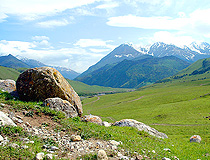
In the mountainous part of Ingushetia
Author: Mikhail Malyshev

Mountains of the Ingushetia Republic
Author: Amirkhan Khakiev
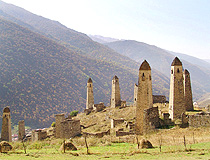
Architectural monuments of Ingushetia
Author: Amirkhan Khakiev
Ingushetia - Features
Ingushetia is the smallest region of the Russian Federation, not counting federal cities. The length of the republic from north to south is 144 km, from west to east - 72 km. Because of the territorial disputes the exact area of Ingushetia is unknown, in most cases it varies from about 3,400 to 3,700 square kilometers.
The republic’s name comes from the Russian name of the local population (the Ingush - from the name of the village of Angusht) and the Georgian suffix -eti together meaning “the place where the Ingush live”.
Ingushetia is the region with the highest birth rate in Russia. National composition according to the 2010 Census: Ingush (94.1%), Chechens (4.6%), Russians (0.8%). Ingush and Russian are the official languages of the republic. The dominant religion is Sunni Islam.
The highest point of Ingushetia is Mount Shan (4,451 m). The length of the Caucasus Mountains on the territory of Ingushetia is about 150 km. The main river is the Sunzha. The climate is continental, alpine, depending on the height above sea level.
The natives of Ingushetia are the Ingushs. They refer to themselves as Galgai, the name of one of the main tribes. The locals are also known by the following names: Amazons, Dzoordzook, Fyappi, Galash, Gegar, Gelgai, Gergar, Ghalghai, Glivi, Jairakh, Khamhoi, Kist, Koost, Metshal, Narts, Nyasareth, Ongusht, and Tsori.
The total number of medieval towers in Ingushetia is about two thousand.
Wood carving, stone carving, artistic metal processing, carpet weaving, embroidery with gold and silver threads are the main preserved folk crafts.
Ingushetia - Economy
There are oil and natural gas fields, supplies of limestone, clay, mineral waters in the republic. Forests cover an area of about 84,000 hectares.
Ingushetia is an agrarian-industrial republic. The main crops are corn, sunflower, vegetables, potatoes. Viticulture and tobacco cultivation are also quite well developed. Traditional areas of livestock are cattle breeding, as well as sheep and goat breeding.
Ingushetia industry is poorly developed. The most developed are oil, petrochemical, chemical, gas processing and metalworking industries. Oil production on the territory of Ingushetia is conducted since 1915.
North Caucasus Railway and the federal highway “Rostov-Baku” pass through the territory of Ingushetia.
Attractions of Ingushetia
“Nine Towers”, a memorial complex and a museum in Nazran, is dedicated to the victims of repression. This is one of the main attractions of the Republic of Ingushetia. The complex has a form of nine mountain towers combined together and reflects the history of the people of Ingushetia.
Thaba-Yerdy Church, located in the Dzheyrakhsky district, is the oldest Christian church in Russia, a monument of architecture of the 8th-9th centuries. During a long time, this church was the main place of worship of mountain Ingushetia, its spiritual and cultural center.
Borga-Kash Mausoleum - one of the earliest surviving Muslim monuments in Ingushetia. The mausoleum is located in the north-western outskirts of the village of Plievo, on the left bank of the Sunzha River.
Myattsil Sanctuary - one of the three places of worship located on Mount Mat-lom.
Metshal village - the complex of towers located on a spur of Mount Mat-lom. This tower complex was an administrative, cultural and economic center of the late-medieval Jeirakh Metshalsky mountain-Ingush society.
Erzi village - a complex of residential and combat towers reaching 25-30 meters in height.
Vovnushki village has towers built in the 16th-17th centuries - a complex of buildings included in Jeirakh-Assinsky museum-reserve.
Jeirakh-Assinsky historical, architectural and natural museum-reserve includes the mountainous area and such natural monuments as Targimskaya valley, the gorges of the rivers Armkhi and Assa.
“Armkhi” sanatorium in Jeirakh gorge. The resort, protected from winds by ridges covered with pine forests, has its own ski slope.


